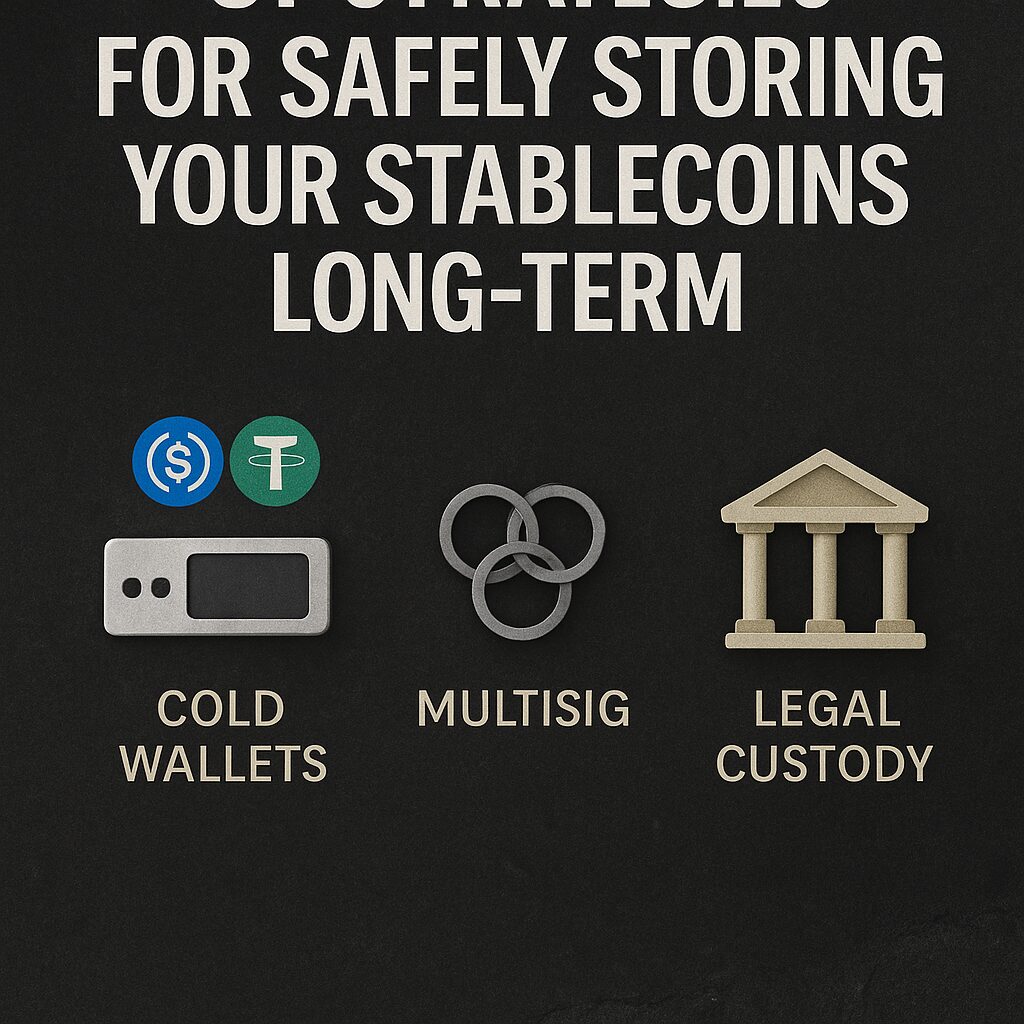Note: This article is for informational purposes only and does not constitute legal or financial advice. Always consult professionals for your specific circumstances.
Why Long-Term Stablecoin Storage Needs Its Own Strategy
Stablecoins are often seen as “safe” — after all, they’re not volatile like Bitcoin or Ethereum, right?
Wrong.
While stablecoins avoid market fluctuations, they are still vulnerable to hacks, smart contract bugs, regulatory freezes, and platform shutdowns.
If you plan to hold stablecoins for months or years — especially large amounts — you need a secure storage strategy.
This guide walks you through advanced yet practical ways to store stablecoins safely over the long term — using cold wallets, multisig systems, legal custodians, and hybrid solutions.
1. Understand the Real Risks of Holding Stablecoins
Stable ≠ Risk-Free.
Here are the most common threats:
- Exchange bankruptcy (FTX, Celsius)
- Platform freezes (USDC and USDT can be blacklisted)
- Phishing and social engineering attacks
- Lost access (seed phrases, keys)
- Government seizures or legal disputes
The goal is not just to keep coins safe — but also accessible, verifiable, and legally sound.
2. Cold Wallets: Best for Solo Long-Term Holders
Cold wallets are offline wallets that store private keys away from internet exposure.
Types:
- Hardware wallets: Ledger, Trezor, Keystone
- Paper wallets: Not recommended unless generated securely
- Air-gapped devices: Offline computers used only for signing transactions
Pros:
- Immune to online hacks
- Total self-sovereignty
Cons:
- Lose your seed = lose everything
- Requires backup & management discipline
Always use:
- Encrypted offline backups (metal plates, USB drives)
- Multilocation storage (split backup in different places)
3. Multisig Wallets: Shared Control for Families, Teams, or High-Value Holdings
Multisig = multiple signatures required to move funds.
Examples: Gnosis Safe, Specter, Caravan
Use cases:
- Family fund shared by 3 people (2-of-3 needed)
- Startup treasury controlled by 3 founders (3-of-5 rule)
- Estate planning (1 key with lawyer, 1 with spouse, 1 with you)
Benefits:
- Reduces single-point-of-failure risk
- Useful for legacy and inheritance planning
Don’t forget:
- Manage who holds which keys
- Document procedures in case of death or incapacity
4. Legal Custody Solutions: When You Need Institutional Protection
For amounts above $100K, or if you’re a business, trust, or DAO — consider third-party custody.
Top crypto custodians:
- Coinbase Custody
- BitGo
- Anchorage
- Fireblocks
Advantages:
- Insurance options
- Secure multi-layer access
- Legal documentation for tax, audit, estate
Drawbacks:
- Requires KYC
- Fees (0.1–0.5% annually or more)
- Less flexible than self-custody
5. Tokenization of Custody: Smart Contract Vaults
Some protocols offer decentralized custody via smart contracts:
- Balancer, Yearn Vaults for passive earnings
- MakerDAO vaults for overcollateralized positions
- Zapper for yield aggregators
Risks:
- Smart contract bugs
- Protocol failure
- Governance manipulation
Use audited protocols only
Always test with small amounts first
6. Hybrid Storage Strategy: Combine Methods Based on Use Case
You don’t have to choose just one.
Smart holders use a layered approach:
| Purpose | Storage Method |
|---|---|
| Emergency fund | Mobile wallet or crypto debit card |
| Passive reserve | Cold wallet (Ledger/Trezor) |
| High-value core | Multisig or legal custody |
| Small earning pot | Smart contract vault (DeFi) |
Diversification reduces risk from any single point of failure.
7. Legal & Legacy Planning for Stablecoins
You don’t just want to store — you want your assets to outlive you.
What happens to your stablecoins if you’re gone tomorrow?
Best practices:
- Write down recovery instructions (offline, encrypted)
- Involve a trusted legal party (lawyer or executor)
- Consider using crypto estate services (Casa, Trustology)
Don’t assume loved ones understand crypto. Train them or leave clear instructions.
Conclusion: Your Wallet Is Your Vault — Make It Secure
Stablecoins are powerful, but they’re only as safe as where you store them.
From cold wallets and multisig to full legal custody, your strategy should match your risk tolerance, legal needs, and long-term goals.
Store with purpose. Diversify for resilience. Plan for continuity.
